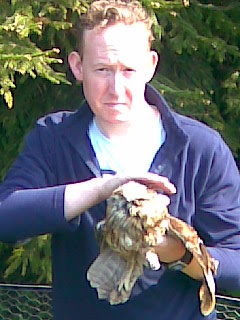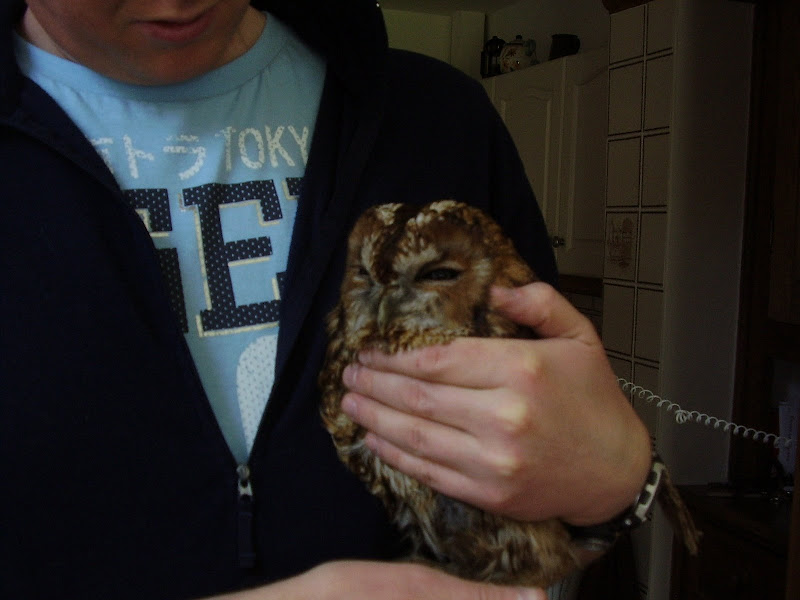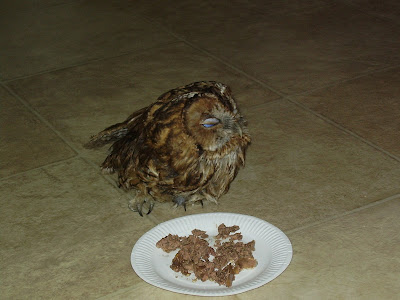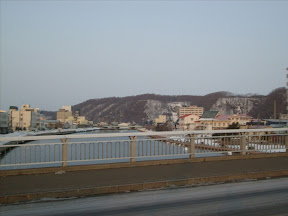
Waking early, I surveyed the buildings around my hotel from my little window. At 6.00, Abashiri was cold,
very cold. Apparently a place well-known for its prisons, both an old one that's now a museum, and a shiny new one. Even if correctional facilities aren't your thing, there seems to be a
surprising amount to do and see in
Abashiri, but unfortunately I was on a mission - a mission to get back to Hakodate by nightfall. As I peered around, a little way away something
caught my eye; a bridge over the Abashiri River with a pair of bird statues set into the central point at either side.
Leaving my hotel and setting off down the way I'd skated the previous night, I stopped by for a
closer look. The statues were of the
Red-Crowned Crane, a creature synonymous with the winter scenes all over Hokkaido (and the subject of many a postcard set). People from all over the world come to birdwatch as these cranes arrive from Siberia in January and do their mating dances, and my time in Hokkaido has been peppered with posters, statues and signs indicating their place in the hearts of the local population.
Not having long, I carried on my way, stopping only briefly to attempt a picture of my Speaks' carrier bag next to the
helpful signs down the side of the road. I should explain:
Speaks is a shop in Keighley that sells all sorts of hiking/outdoor wear, and a tradition amongst its customers is to take a picture of themselves in a far-off place clutching one of their carrier bags. Go inside and the place is full of such pictures, and upon buying my trekking boots for the trip, I decided that I would join them. Thus in Hokkaido, just about as far away from Keighley as you could get, I was looking out for suitable places, preferably with a sign of the place I was in, to take a picture.
On each of the pavements was a 3ft drift, which, if it would take my weight, would allow a good picture of both the bag and the signage. Unfortunately, a good 10 minutes were wasted aligning the camera and the bag whilst being blown by wind and sinking slowly into the drift.
This is the best I could get. Looking at my watch, I decided that would have to be it for Abashiri, and perhaps this was the time to get to the station. I hurriedly made my way along the
icy paths and got there with a few minutes to spare.
The Ainu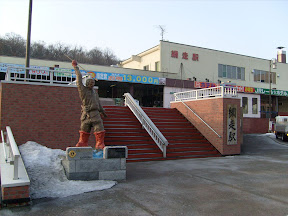
Outside Abashiri station is a statue of one of the indigenous
Ainu people, a race all but suppressed from Japanese history who still live in small groups in the northern areas of Japan. Far from being perfect, as I may have given the impression until now, the Japanese still have unresolved issues in many areas of society, and their treatment of the Ainu race is one of them. Even the name itself has become derogatory in the Japanese language. However there is some recognition in some regions of Japan and this is one such example.
Anyways, my travel from Abashiri to the next destination,
Kushiro, was going to be an interesting one. The connectin
g Senmō main line is one of the least ridden around Japan. Consisting of a single track, narrow gauge, the line is ridden back and forth between the two towns by a
single train carriage, and the one I was taking was leaving at 6.40. The next was hours away.
And so we set off. The only passengers to get on at this point were a couple of older residents of either Abashiri or Kushiro, (it was hard to tell), but as the train passed
local stop after
local stop, it slowly filled up with schoolchildren who chattered and gossiped amongst themselves by the doors, no doubt including the strange-looking foreigner in their conversations more than once.
The
views were
cold and
harsh-looking, but had
raw beauty. Once out of Abashiri, the track roughly followed the east coast, moving inland and then back out again, passing through some of the most rural and traditional sights perhaps remaining in the country, and where it
brushed the coastline, it would have been pefect for travelling on one of the icebreaker ships that take tourists round the cape. Inland, eagles, foxes, bears, cranes and kites were all spotted darting away as the train clattered by (largely too quick for my camera unfortunately).
As we hit
Midori, the children got off to go to school and the rest of the way the train filled more with elderly residents heading to the south coast. A little further, the train entered a tunnel, and when it emerged out the other side, we were in the
Akan National Park. This train line is unusual in that its the only one in Japan that is allowed to go through a national park, and some of the views were
fantastic.
Finally, we started to enter some civilisation once more. The
snow receded a little and buildings began to spring up. As we got off at Kushiro, it felt like I was finally on the return leg. With a half hour or so to spare, there was just enough time to
poke my nose out of the station, and look briefly in at their
steam railway display, though unfortunately not enough to take the train further still to the east to
Nemuro, which is just about as eastern as you can get (that will have to wait until I return). Just outside - a perfect photo opportunity for my Speaks bag - so I rope in a semi-willing bystander to take my picture, and
this is the result, now proudly hanging somewhere in Speaks.
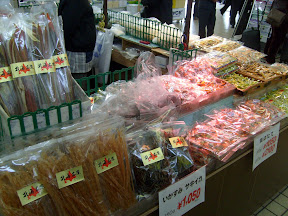
Just before leaving, I happened upon a stall in the middle of the station foyer selling what appeared to be sweets, but on closer inspection, werent. They were bits of dried and cured fish and seafood delicacies, put in shiny foil wrappers like sweets would be. Spying a potential customer, or perhaps finniky foreign victim, the lady behind the counter gave me a free sample to try, which as I'd made eye contact by now, I felt I couldn't refuse. Opening the wrapper, a small, compacted 'thing' appeared. Something that looked as if it was once gills, or some sort of pipe from one organ to another. I took a breath and popped it into my mouth, trying not to think too much. Initially hard, it became chewy and after the first minute of shock my taste buds actually quite liked it, though I couldn't see myself popping a dozen or so slobbed out in front of the telly. Even so, a little bit of culinary Hokkaido could be sort added to the list.
As the train departed from Kushiro, and the last of the taste had been washed away with some Pocari Sweat, my camera batteries packed in just as a
fog descended over the area. Top tip: Always bring spare batteries. The train line slowly made its way north-east towards
Shintoku, where I departed for a more direct route to Sapporo. It's a shame the batteries had died, because the trip between Shintoku and Sapporo was one of the most picturesque views I had seen of Hokkaido, though that may just have been because I wasn't looking through a viewfinder all the time.
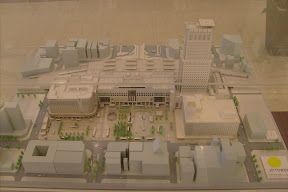
Back in
Sapporo, I had a little time again, so I bought some nosh, and a few spare batteries, and then headed for the only sightseeing location to hand: the
JR Sapporo Tower. Even though it was part of the station, the entrance to the damn thing was difficult to find. However as had happened many times before, I was able to find someone to help me get there. In this case, a businesslike-looking gent, instead of pointing me in the right direction as I had expected, actually led me halfway across the station and acted as my interpreter as we solved the Sapporo Tower riddle of where the hell the lift was. At the top, I was greeted with
great views of the
surrounding city, but I had stayed a little too long and my intended other destination, the internet cafe I had visitied on my way through Sapporo the first time, was going to be a rush. I quickly bought some postcards as souvineers from the
shop (which I had done elsewhere since postcards were some of the few things to fit my already overfilled backpacks) and sped out and down the street.
Entering the cafe at some speed, I had about 20 minutes to get my card into a slot and upload my photos. Typically, the place was packed, and 5 minutes were taken up waiting for a terminal to become free. Things got worse still when my PC of choice was knacked, and a dodgy connection somewhere meant that the power failed twice before even getting onto my email account. Sweating and annoyed, I went back to the counter and tried to explain in my slightly-less-than-shouting-at-foreigners voice that I couldn't and wouldn't pay, because my machine was crap and I had to get a train. Eventually between us I got through to them and made my train to Hakodate, during which I cursed more than once as I watched the sun
set.
Back in Hakodate, the daylight had disappeared and I was tired. I got my bag back from the place it had been for the past 24 hours or so (fortunately no-one had thought to nick it) and tried once more to get on the hotels free internet, succeeding this time, and probably staying longer than I had a right to uploading photos and sending mail.
Yet again, I had spent time in Japan and yet somehow had not. Hokkaido was just one big blur, and by this point I had decided I was coming again and doing it slower, savouring the sights and not having to worry one moment to the next about when the next train leaves. Three and a bit weeks is just not enough by a long stretch. However, this was trip #1,
one more day of mad rushing around on trains, I thought, and then things begin to slow down a little once I'm back in Honshu.
